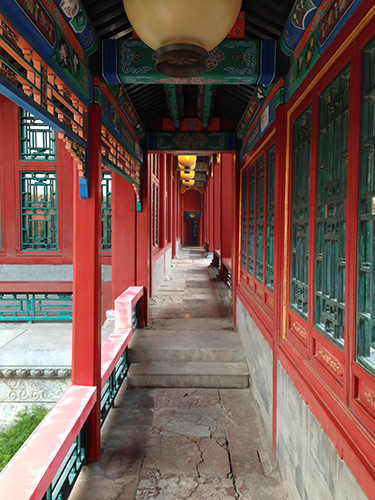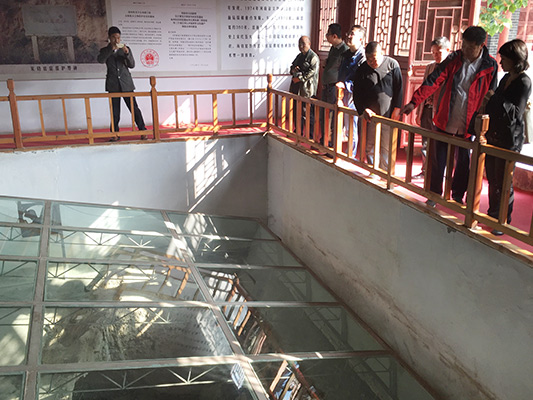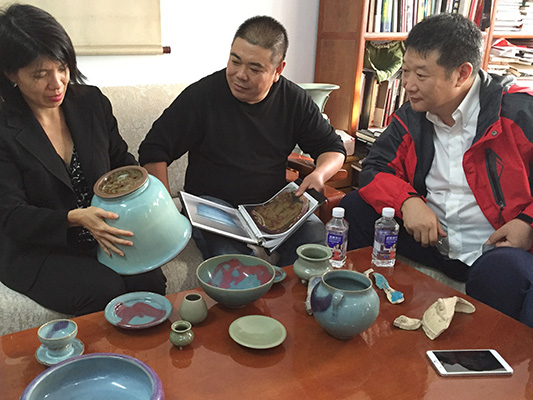While researching rare Chinese ceramic vessels for an upcoming exhibition, curator Melissa Moy and curatorial assistant Yan Yang went straight to the source. Moy had already been planning to attend the 2016 Forum for Curators of Chinese Art in Beijing, in part to hear colleague Katherine Eremin, the museums’ Patricia Cornwell Senior Conservation Scientist, give a presentation about Chinese works in our collections. Moy asked Yang to accompany her so that they could visit not only the province where these rare vessels originated but also Beijing’s Forbidden City, the former imperial palace where some of them were once displayed.
The vessels, known as numbered Jun wares because of the marks of Chinese numerals on their bases, are renowned for their blue and purple or magenta glazes. They relate to a family of northern Chinese ceramics called Jun ware, which were produced as early as the 11th or 12th century; the origins of numbered Jun ware, however, are still debated. These unique numbered vessels were originally intended to display flowers or plants, but by the 18th century, they were collected as art objects and adorned the inner court of Beijing’s Forbidden City.
“The rarity of these ceramics and their connections to the imperial palace are especially intriguing to me,” said Moy, the Alan J. Dworsky Associate Curator of Chinese Art, who credits her curatorial predecessor Robert Mowry with introducing her to the vessels. Since then, Moy has devoted years of research to Jun ware, even writing her master’s thesis on the objects. This research deeply informs the museums’ upcoming exhibition Adorning the Inner Court: Jun Ware for the Chinese Palace, on view May 20 through August 13, 2017.
With 60 pieces of numbered Jun ware in our collections, the Harvard Art Museums have the largest and finest assemblage of such objects outside of imperial holdings in Beijing and Taipei. A selection will be shown in the exhibition, including vessels that are inscribed with the names of specific palaces within the Forbidden City where they were once kept.
Imperial Origins
Moy and Eremin visited one of the palaces named on our objects, the Palace of Established Happiness—a rare opportunity because it is normally closed to the public.
“It was exciting to be in one of the physical spaces where these wares were once used—to imagine how the emperors and their families admired these vessels so much that they kept select examples in their private quarters and even marked them with palace names to ensure that they stayed in one place. It’s fascinating to think of these functional objects as worthy of the emperor’s attention,” Moy said.
Moy and Eremin also toured the conservation labs at the Forbidden City (now known as the Palace Museum Beijing). It was an eye-opening experience, given the enormity of the museum’s collection. Later, Moy, Eremin, and Yang met and discussed Jun ware with Lü Chenglong, deputy director of the antiquities department at the Palace Museum Beijing, and Geng Baochang, an eminent ceramics expert and curator of Chinese ceramics.
Finally, they were treated to a private viewing of 10 of the Palace Museum Beijing’s own numbered Jun wares. The experience, they said, was invaluable. “One can make simple observations from an image, but nothing surpasses handling an object in person—viewing an object fully in the round, turning it over, feeling its weight and texture, and closely examining features in the glaze,” Moy said.
The experts helped suggest new resources and historical records for Moy and Yang’s research, which ultimately bolstered their knowledge of the Harvard Art Museums’ numbered Jun wares. For example, they were able to confirm a longstanding belief that the inscriptions were made at one emperor’s command—an indication of how much the leader valued his Jun ware.
New Insights into the Artistic Process
After spending time in Beijing, Moy and Yang traveled south to Henan province, where Jun ware is believed to have originated. They visited the Jun Royal Kiln Site Museum in Yuzhou, which was constructed over centuries-old kilns.
After touring the museum and viewing a number of original Jun ware sherds (fragments of ancient pottery), they met with local ceramic artist Liu Zhijun, who creates replicas of numbered Jun wares and offers demonstrations. “It was very informative to see some of his products and ask specific questions about how he makes his Jun ware,” Moy said.
Yang was impressed by Liu’s excellent craftsmanship. “It’s rewarding to witness this thousand-year-old artistic tradition revived in a contemporary potter’s hands,” Yang said.
Although numbered Jun ware may have served an everyday purpose, it’s obvious to Moy and Yang that these vessels are anything but ordinary. Understanding the objects requires an interdisciplinary approach, encompassing concepts and techniques from art history, scientific analysis, archaeology, and more.
The Adorning the Inner Court exhibition will show that the story behind these objects is still hotly debated and richly layered. As Moy said, “These aren’t just simple flower pots; they are technically sophisticated objects with a very special history.”






